6a66f500144c4e7d812fdc3bdb0fdb8f/com-top-tier-images/deansnewsletter/recurring_graphics/lm-newsletterheader-blue_2020(3).jpg?sfvrsn=a22abbf2_2)
February 23, 2022 | Volume IV, Issue 4
/com-top-tier-images/deansnewsletter/into_the_fray(1).jpg?sfvrsn=96ae78c0_2)
A Very Different Beginning of Residency
Medical students in the Larner Class of 2020 celebrated their Match Day on March 20, 2020 just nine days after the World Health Organization declared COVID-19 a global pandemic. Their online Match ceremony—the first of many Zoom events—signaled just how different the start of their medical careers would be from those of previous classes. In a matter of weeks, as cases surged, and caregivers dealt with a shortage of both knowledge of the novel virus and basic protective gear, they began residencies at medical centers across the country.
“Normally, there’s a hierarchy of decision-making and what correlates with that is a hierarchy of knowledge,” says, Collin York, M.D.’20, an internal medicine resident at the University of Virginia. “But in many cases, the knowledge would be so new, and there were so many unknowns about COVID, that you’d find yourself in rounds, looking to the ‘expert,’ and they would shrug their shoulders and not quite know what to do.”
The Class of 2020 physicians felt the anxiety and uncertainty all new residents have, while contending with an unmatched public health crisis. In the latest issue of Vermont Medicine, members of the class have shared thoughts on some of their experiences as the pandemic unfolded around them.
Read the Vermont Medicine story.
Pictured above: A blurred image of an ambulance in motion at night. Red font reads “Into the Fray.”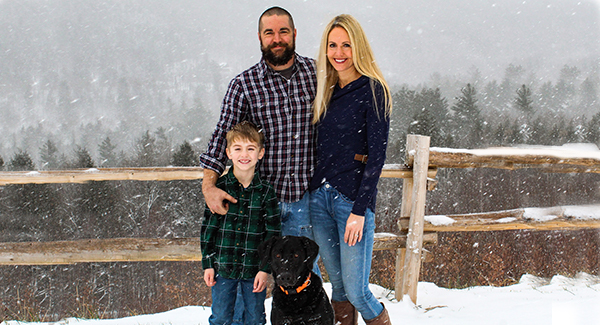
Heart Month: Bouncing Back after Atypical Heart Attack
It was summer 2021, when, two miles from home, a sudden pain stopped 44-year-old Sara Rutledge in her tracks. As a burning feeling crept into her chest, her black lab, Goose, turned and looked back, curious why their daily run was being cut short.
Could it be the poor air quality from western wildfire smoke migrating to the Green Mountains, or was she dehydrated or overexerted? As she caught her breath and took a few sips of water, the pain intensified, shifting to her back and arms.
“I didn’t know what was happening, but I knew something was very wrong,” says the Fayston, Vt., resident, adding, “I knew I had to get help.”
That help came first at Central Vermont Medical Center's (CVMC) Emergency Department. Amos Hare, P.A., a CVMC physician’s assistant, consulted with cardiologists at UVM Medical Center and arranged Rutledge’s transfer there.
In Burlington, cardiologist and Associate Professor of Medicine Marc Tischler, M.D., diagnosed Rutledge with a spontaneous coronary artery dissection, or SCAD, which occurs when a tear in an otherwise normal artery blocks the flow of blood to the heart.
Jamie Rowell, M.D., a clinical instructor and third-year resident in internal medicine at UVM Medical Center, cared for Rutledge during her inpatient stay.
“When patients are hospitalized with a rare condition…making the diagnosis is only half the battle,” says Dr. Rowell. In such cases, she advocates for taking the time to explain a diagnosis and discuss how the condition may affect the patient’s life after they are discharged.
Pictured above: Sara Rutledge (far right) with her husband, son, and dog. (Courtesy photo).

Complete the UVM Campus Climate Survey!
All UVM Larner College of Medicine faculty, staff, post-doctoral trainees, medical students, and graduate students are strongly encouraged to take the UVM Campus Climate Survey. Your feedback is valuable and important. Link to survey.
/com-top-tier-images/deansnewsletter/newsletter_feature(2).jpg?sfvrsn=e0727d76_2)
Reinventing the Wheel with Open-Source Science
Like most inventions, the Lockable Open-Source Training (LOST) Wheel, a 3D-printable open-source rodent wheel created by J.J. Bivona, Ph.D.’22, was born of necessity.
A current University of Vermont postdoctoral fellow and recent Cellular, Molecular, & Biomedical Sciences alum, Dr. Bivona had been working on a grant-funded project in the laboratory of Professor of Medicine Matthew Poynter, Ph.D., which aimed to identify myocyte involvement in inflammation and examine if exercise might diminish prolonged inflammation. The research relied heavily on the study of mouse models after they exercise, but commercially available rodent treadmills and wheels didn’t meet Dr. Bivona’s budget and functionality needs. Frustrated with the price and limitations of commercial mouse wheels, he set out to not only create his own, but do so in a reproduceable way that could help other researchers in similar situations.
“Labs in the top 10 percent of funding receive 45 percent of the research project grants, which makes the funding pool for everyone else much smaller,” says Dr. Bivona. “They already have the expensive tools and machines necessary to make the latest and greatest technologies and breakthroughs.”
By making the LOST-Wheel open-source, he hopes to play a part in interrupting that cycle and, in doing so, help early career researchers like himself contribute meaningfully to current scientific discourse.
His mentor, Dr. Poynter, sees the enduring value of an open-source tool.
“The motivation for being a biomedical scientist in an academic setting is to bring new knowledge to an audience who is able to use it to move the field forward and, eventually, contribute to helping humanity,” says Poynter. “Oftentimes, the brightest and most innovative minds are those waiting to be inspired, or without the resources to enable them to conduct meaningful work. Providing information and materials in an open-source manner may enable such high-potential individuals to make scientific contributions that they may not otherwise be able to do.”
Read the full story and view video tutorials and manuals for the LOST-Wheel.
Pictured above: Dr. Bivona sits as his desk in the Poynter lab wearing a black cloth face mask and holding up a prototype of the LOST-Wheel.
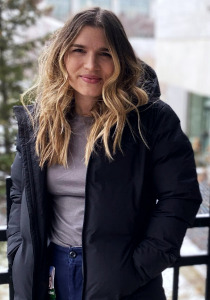
Since beginning medical school at the UVM Larner College of Medicine in Vermont (the state where the first major U.S. polio outbreak occurred), my curiosity about vaccines has evolved into an interest in vaccine equity—promoting fair and just access in communities with structural barriers such as historical racism, limited resources, or zip code. In between studying, I have spent my time trying to understand and mitigate the challenges Vermonters face related to avoiding vaccine-preventable illness. What I did not expect was that I’d also have a role in advocating for vaccination in my personal, very privileged life.”
– Finlay Pilcher, Class of 2024 Medical Student
(Excerpted from UVM Larner Med Blog post by Finlay Pilcher.)
Pictured: Finlay Pilcher poses for a photo outside of the UVM Given and Medical Education Buildings on a snowy cloudy day.
Accolades & Appointments
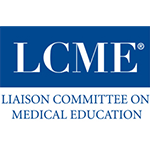
On February 10, 2022, Larner College of Medicine medical student Matt Brandt ’22, alum Sidney Hilker, M.D.’21, and medical student Vinh Le ’23 were guest speakers during the Liaison Committee on Medical Education (LCME) “Connecting with the Secretariat” webinar. They discussed the College of Medicine’s general student involvement in the LCME self-study and site visit processes and shared how the College’s ISA committee organized, designed and launched the survey, prepared the report, and communicated the results. Larner students achieved a 100 percent response rate across all four classes for the 2021 ISA.
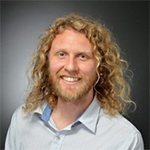
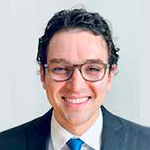
/com-top-tier-images/deansnewsletter/newsletter_accolade_photo(1).jpg?sfvrsn=60b3be3c_2)
“Things We Do for No Reason™: Routine Inclusion of Race in the History of Present Illness,” a paper authored by UVM Larner College of Medicine medical alum Jonathan Gau, M.D.’21 (at left), was recently published in the Journal of Hospital Medicine. In addition to Dr. Gau, who is currently an internal medicine resident at University of California Irvine Medical Center, coauthors include UVM Professors of Medicine Tim Lahey, M.D., and Allen Repp, M.D.; Christle Nwora, M.D., an internal medicine resident at Johns Hopkins University; Shaden Eldakar-Hein, M.D., former Larner interim assistant dean for medical students and current senior associate dean at Lewis Katz School of Medicine at Temple University; and Mita Goel, M.D., M.P.H., associate professor of medicine at the Feinberg School of Medicine.
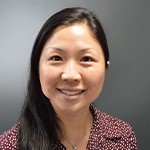
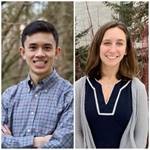
Class of 2024 medical student Elise Prehoda (pictured at left, right photo) has been elected president-elect for the UVM Larner College of Medicine Medical Student Council. Current President-Elect Vinh Le ’23 (pictured at left, left photo) will transition into his new role as the 2022-2023 Medical Student Council president on March 18, succeeding current president, Patrick Clarke ’22.
/com-top-tier-images/deansnewsletter/vbb_(2).png?sfvrsn=e3333c1d_2)
The Vermont Brain Bee took place at the Larner College of Medicine on February 12 and was sponsored by the UVM Neuroscience Graduate Program (NGP), Vermont Chapter of the Society for Neuroscience, and a number of local businesses and organizations. A group of four Larner community members helped plan and execute the event, including NGP students Jenan Husain and Dan Peipert, second year medical student Elise Prehoda, and Molly Hurd, M.S., a laboratory technician in the Department of Neurological Sciences. After taking place virtually in 2021, the 2022 Bee had eight young women participants representing five local high schools. The students took part in three rounds of competition—a written quiz, a practical exam, and an oral round. Event facilitators were Nate Jebbett, Ph.D., assistant professor of neurological sciences, and Lisa Bernardin, M.S., Vermont Brain Bee coordinator. All of the questions posed during the competition were based on the brain facts published by the Society of Neuroscience. The first place winner is Hlba Ali, a senior at South Burlington High School. Second place winner is Deepika Muthuswamy, also a senior from South Burlington High School. The third place winner is Uma Chirkova, a sophomore from St. Johnsbury Academy.
(Pictured, top, from left to right) Jenan Husain, Molly Hurd, Elise Prehoda and Dan Peipert. (Pictured, bottom left) Dr. Jebbett (far left) and Lisa Bernardin (far right) pose with the eight participants.CITATION HIGHLIGHTS
Nowak SA, Parker AM, Gidengil CA, Richardson AS, Walsh MM, Kennedy DP, Vardavas R. Reciprocal relationships among influenza experiences, perceptions, and behavior: Results from a national, longitudinal survey of United States adults. Soc Sci Med. 2022 Jan 11;296:114693. doi: 10.1016/j.socscimed.2021.114693. Epub ahead of print. PMID: 35086022.
Peper KM, Guo B, Long DL, Howard G, Carson AP, Howard VJ, Judd SE, Zakai NA, Cherrington A, Cushman M, Plante TB. C-reactive protein and racial differences in type 2 diabetes incidence: The REGARDS study. J Clin Endocrinol Metab. 2022 Feb 8:dgac074. doi: 10.1210/clinem/dgac074. Epub ahead of print. PMID: 35137178.
Peper K, Gerges D, Sajisevi M. Cystic Neck Mass in a Middle-aged Woman. JAMA Otolaryngol Head Neck Surg. 2021 Nov 1;147(11):999-1000. doi: 10.1001/jamaoto.2021.2400. PMID: 34529052.
Dixon AE, Que LG. Obesity and Asthma. Semin Respir Crit Care Med. 2022 Feb17. doi: 10.1055/s-0042-1742384. Epub ahead of print. PMID: 35176784.
Ahern TP, Spector LG, Damkier P, Öztürk Esen B, Ulrichsen SP, Eriksen K, Lash TL, Sørensen HT, Cronin-Fenton DP. Medication-Associated Phthalate Exposure and Childhood Cancer Incidence. J Natl Cancer Inst. 2022 Feb 18:djac045. doi: 10.1093/jnci/djac045. Epub ahead of print. PMID: 35179607.
Ketcher D, Reblin M, Mansfield KJ, McCormick R, Skinner AM, Otto AK, Tennant K, Wawrzynski SE, Reed DR, Cloyes KG. "It's Kind of Complicated": A Qualitative Exploration of Perceived Social Support in Young Adult and Young Adult Lesbian, Gay, Bisexual, Transgender, and/or Queer Cancer Survivors. J Adolesc Young Adult Oncol. 2022 Feb 14. doi: 10.1089/jayao.2021.0210. Epub ahead of print. PMID: 35166594.
Keyloun JW, Le TD, Orfeo T, Brummel-Ziedins KE, Bravo MC, Kaye MD, Bourne DE, Carney BC, Freeman K, Mann KG, Pusateri AE, Shupp JW; SYSCOT Study Group. Assessing Factor V Antigen and Degradation Products in Burn and Trauma Patients. J Surg Res. 2022 Feb 15;274:169-177. doi: 10.1016/j.jss.2021.12.049. Epub ahead of print. PMID: 35180493.
Mayhew CR, Gallagher A, Bensimhon A, Dauerman HL, Tsai MH, Martin JA. Cost- effectiveness analysis of a resource-intensive approach versus minimally invasive strategy for high-risk transcatheter aortic valve replacement patients. J Comp Eff Res. 2022 Feb 10. doi: 10.2217/cer-2021-0210. Epub ahead of print. PMID: 35142536.
Ivanova MY, Achenbach TM, Turner L, Almqvist F, Begovac I, Bilenberg N, Bird H, Broberg AG, Córdova Calderón MA, Chahed M, Dang HM, Dobrean A, Döpfner M, Erol N, Forns M, Guðmundsson HS, Hannesdóttir H, Hewitt-Ramirez N, Kanbayashi Y, Karki S, Koot HM, Lambert MC, Leung P, Magai DN, Maggiolini A, Metzke CW, Minaei A, Monzani da Rocha M, Moreira PAS, Mulatu MS, Nøvik TS, Oh KJ, Petot D, Petot JM, Pisa C, Pomalima R, Roussos A, Rudan V, Sawyer MG, Shahini M, Simsek Z, Steinhausen HC, Verhulst FC, Weintraub S, Weiss B, Wolanczyk T, Zhang EY, Zilber N, Žukauskienė R. Effects of individual differences, society, and culture on youth-rated problems and strengths in 38 societies. J Child Psychol Psychiatry. 2022 Feb 15. doi: 10.1111/jcpp.13569. Epub ahead of print. PMID: 35167140.
Hehir MK, Conaway M, Clark EM, Aronzon DB, Kolb N, Kolb A, Ruzhansky K, Sadjadi R, De Sousa EA, Burns TM. The Adverse Event Unit (AEU): A novel metric to measure the burden of treatment adverse events. PLoS One. 2022 Feb 17;17(2):e0262109. doi: 10.1371/journal.pone.0262109. PMID: 35176061; PMCID: PMC8853570.
GRANTS REPORT: UVM SPONSORED PROGRAM ADMINISTRATION
Annual/Monthly Reports for Sponsored Projects
WHAT'S HAPPENING
LCOM Events Calendar | UVM Events Calendar | LCOM Student Activities Calendar
Feedback? Contact Us!
View Archive | Subscribe
Published by the Office of Medical Communications
The Larner College of Medicine
at The University of Vermont
Copyright 2022



